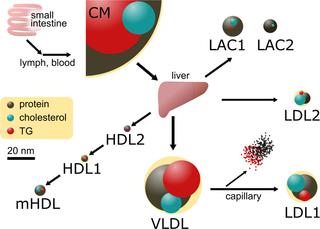PLOS ONE ( IF 2.9 ) Pub Date : 2019-01-17 , DOI: 10.1371/journal.pone.0210950 Yoko Takahashi , Tomokazu Konishi , Kohji Yamaki

|
Soy protein and fish oil are food components that decrease the risk of cardiovascular disease. Previous studies demonstrated that these food components reduced serum cholesterol levels and suppressed hepatic lipogenesis. However, the underlying mechanisms of action of these food components remain unclear. Ten classes of serum lipoprotein profiles showed that dietary tofu, a soybean curd, suppressed cholesterol absorption, while fish oil reduced most of the lipoprotein classes in rats. Tofu and fish oil both halved the level of the lipoprotein class LAC1 (LDL-anti-protease complex), a 15-nm LDL-anti-protease complex, which is speculated to be a cause of atherosclerosis. Moreover, a global transcriptome analysis revealed that tofu inhibited the mRNA expression of genes involved in hepatic lipogenesis, while fish oil stimulated that of genes related to fatty acid degradation. Therefore, tofu and fish oil independently regulate lipid metabolism. The decrease observed in LAC1 may have been due to reduced cholesterol absorption in the tofu diet group and the interference of lipogenesis via the activation of polyunsaturated fatty acid detoxification in the fish oil group.
中文翻译:

豆腐和鱼油可独立调节大鼠的血脂谱:10类脂蛋白谱和全球肝转录组的分析
大豆蛋白和鱼油是降低心血管疾病风险的食品成分。先前的研究表明,这些食物成分可降低血清胆固醇水平并抑制肝脏脂肪生成。但是,这些食物成分的基本作用机理仍不清楚。十类血清脂蛋白谱显示,豆腐(一种豆腐)抑制胆固醇的吸收,而鱼油则减少了大鼠中大多数脂蛋白的分布。豆腐和鱼油都将脂蛋白类LAC1(LDL-抗蛋白酶复合物)(一种15 nm LDL-抗蛋白酶复合物)的水平降低了一半,这被认为是引起动脉粥样硬化的原因。此外,全球转录组分析显示豆腐抑制了与肝脂肪形成有关的基因的mRNA表达,鱼油刺激了与脂肪酸降解有关的基因。因此,豆腐和鱼油可独立调节脂质代谢。在LAC1中观察到的减少可能是由于豆腐饮食组中胆固醇的吸收减少,以及鱼油组中通过激活多不饱和脂肪酸解毒而引起的脂肪生成干扰。











































 京公网安备 11010802027423号
京公网安备 11010802027423号